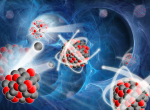Can Deplted Uranium Be Used Again
- Level 1: Summary
- Level 2: Details
- Level 3: Source
- Virtually
- Links
Depleted uranium is a dumbo metal produced as a by-product of enrichment of natural uranium for nuclear fuel. It is yet radioactive, just at a much lower level than the starting material. It is used in armour-piercing shells and bombs, to requite them more penetrating ability. Such munitions were used in both Gulf Wars and in Serbia and Kosovo. Their use has raised concerns about health threats from exposure to the distributed uranium. Many studies accept reported a lack of evidence of take a chance, just their results remain controversial. The European Parliament in 2008 asked for more data about the scientific discipline of depleted uranium and on where information technology can exist institute.What is the latest and best evidence on the environmental and health risks of depleted uranium, especially later its armed forces use?
An cess past the Scientific Commission on Health and Environmental Risks (SCHER).
Questions on Depleted Uranium
- Introduction
- What is depleted uranium and how is it used?
- What are the health effects of radiations?
- Does depleted uranium pose a radiation gamble?
- What other effects tin depleted uranium accept on human being wellness?
- What harmful effects tin can uranium have in the environment?
- What is known almost uranium exposure?
- seven.i Natural exposure is a relevant comparing
- vii.ii What happens to depleted uranium in munitions?
- Practice the data betoken whatever health risks or environmental risks from DU residues?
- Decision
The answers to these questions are a true-blue summary of the scientific opinion produced in 2010 by "The Scientific Committee on Wellness and Environmental Risks" (SCHER):
"Opinion on the ecology and health risk posed past depleted uranium"Acquire more...
- Level one: Summary
- Level two: Details
- Level iii: Source
- About
- Links
1. Introduction
Apply of depleted uranium (DU), specially, in munitions, has prompted concerns about health risks of the material.
Previous skilful reviews have ended that there is no conclusive prove of impairment from exposure to DU, only these findings have been disputed.
The Scientific Committee on Wellness and Ecology Risks (SCHER) has reviewed existing reports and the latest scientific literature to appraise the ecology and health risks of DU.
- Level ane: Summary
- Level 2: Details
- Level 3: Source
- About
- Links
2. What is depleted uranium and how is it used?

Depleted uranium is a by-product of enrichment of natural uranium to make nuclear fuel. It is less radioactive than naturally occurring uranium equally it contains less of the fissionable textile U-235.
Uranium is an extremely dumbo metallic, 1.7 times as dense equally lead, and this lends itself to uses where a large mass in a small volume is advantageous. These include armour-piercing shells and bombs. DU-containing ammunition was used in both Gulf Wars, in 1991 and 2003, and in Serbia and Kosovo.
- Level ane: Summary
- Level 2: Details
- Level 3: Source
- Nearly
- Links
three. What are the health effects of radiation?

Radiation tin can cause radiation sickness due to immediate tissue harm. Such damage is seen afterward radiotherapy, industrial accidents, and use of nuclear weapons. Chop-chop reproducing cells, such as those in the lining of the gut, the os marrow, and the pare, are about affected. Very severe exposure causes tissue destruction and is chop-chop fatal.
Radiation sickness is merely seen above a threshold radiation dose. Such doses are not expected to be seen from whatever imaginable pathways of exposure to depleted uranium.
Radiation can besides crusade mutations in Deoxyribonucleic acid, which increases the risk of cancer. The run a risk is usually assumed to increase with the dose with no minimum threshold.
Studies have not shown any definite link between numbers of tumours and radiation doses within the range of background radiation. This may exist due to the difficulty of performing epidemiological studies involving such doses. However, in that location is also some recent biological prove for a threshold in carcinogenic effects for both radiation and chemic impairment.
- Level 1: Summary
- Level 2: Details
- Level 3: Source
- Almost
- Links
4. Does depleted uranium pose a radiations take a chance?
All uranium isotopes are radioactive. DU is appreciably less radioactive – unremarkably around 40 per cent less - than unprocessed uranium. The action is mainly in the course of alpha particles, which do not penetrate the skin. This means radiation hazards from uranium just arise from breathing in dust, eating or drinking contaminated nutrient or water, or from shrapnel inbound the torso.
- Level 1: Summary
- Level ii: Details
- Level 3: Source
- About
- Links
five. What other furnishings can depleted uranium have on human being health?

All isotopes of uranium have the aforementioned chemical toxicity, and this is the likely cause of impairment from depleted uranium.
The human being toxicity of uranium is well-studied. Soluble compounds of uranium which are ingested in food or drink become concentrated in the kidneys, and kidney harm is the best-documented ill-event of uranium toxicity. Studies confirm that the toxicity of DU is identical to naturally occurring uranium. Medical monitoring of Gulf War veterans who suffered shrapnel wounds involving uranium has not so far revealed any serious health furnishings.
- Level 1: Summary
- Level ii: Details
- Level 3: Source
- About
- Links
six. What harmful furnishings can uranium take in the environment?
There is less information on ecological effects of uranium exposure than on man health effects. For human health, toxicity is the master likely crusade of impairment.
- Level 1: Summary
- Level 2: Details
- Level three: Source
- Nearly
- Links
7. What is known nearly uranium exposure?
- vii.1 Natural exposure is a relevant comparison
- 7.2 What happens to depleted uranium in munitions?
7.ane Natural exposure is a relevant comparison
Uranium is naturally nowadays in minerals and soil and, at lower levels, is found in food and drink. The average daily intake of natural uranium in humans is estimated as 1 to 2 μg from food and i.5 μg from drinking water.
7.two What happens to depleted uranium in munitions?

Armour-piercing shells which are on target generate uranium dust and larger fragments of the metal. The grit burns to uranium oxide, and is largely deposited over the inside of the target vehicle. Dust which escapes does not usually travel far because of the density of uranium metallic.
DU munitions which hit the ground bury themselves in the soil, where the uranium oxidises and dissolves over years or decades. Over time, the uranium is removed from about the impact site. Total amounts are not loftier enough to add significantly to the natural uranium background.
Surveys of DU residues from combat zones show mostly depression concentrations of the metal, within the range of naturally occurring uranium, though in that location may also be a small number of "hot spots".
Urine samples from serving soldiers and from civilians living in areas where DU armament has been used, typically betoken very low levels of DU exposure.
- Level ane: Summary
- Level 2: Details
- Level 3: Source
- About
- Links
8. Do the data indicate any health risks or environmental risks from DU residues?
Human DU exposures and intake announced to be below established tolerable levels for uranium, for both chemical and radiological hazard. Environmental monitoring indicates that contamination in war zones is more often than not low, except in areas shut to destroyed vehicles and penetrators. Risks to state-based and water-living life are depression.
- Level ane: Summary
- Level 2: Details
- Level 3: Source
- About
- Links
9. Conclusion
SCHER agrees with the conclusion of earlier expert reviews that ecology and human health risks due to a potential widespread distribution of DU are not expected. Exposure to DU is very limited compared to background exposures.
In combat zones, vehicles hit by DU should exist made inaccessible to the general public and be properly disposed of. Used DU ammunition should too be collected and disposed of.
Source: https://ec.europa.eu/health/scientific_committees/opinions_layman/depleted-uranium/en/index.htm
0 Response to "Can Deplted Uranium Be Used Again"
Post a Comment